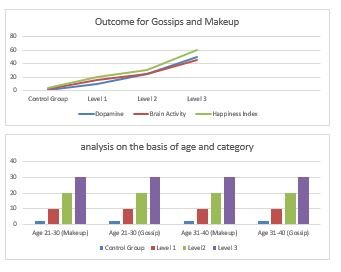Topic: The critical analysis of Effect of Makeup and Gossips on the Females of different age groups.


Abstract / Introduction: It is presumed that females are fond of makeup articles and gossips. The beauty and charm are attributed more to females as compared to male counterparts. This is mostly achieved/retrieved with the help of profound spuriousness either with the help of makeup or by visiting the beauty parlour. Further, the inherent feature of the feminine characteristic is the whispering campaign. The tittle-tattle may involve those conversations which are irrelevant or those details that may be unauthentic.
Background: Makeup and Gossips are the birth-rights of females and no constitution of the universe can seize that privilege from them. Once a king tried to do so, but no one knows, literally, no one, regarding his whereabouts, just after the ordinance of banning makeup and gossips. Ever since no one tried messing with the monopoly of the unpredictable creature.
Objectives: Our team aimed to analyze the effect of makeup and gossips on the females of different age groups. The makeup can cause the neurological and pseudo-dominance effect on the individual and, so with the gossips. The objective is to study the effect of both under different stimuli (physical and emotional).
Study appraisal and synthesis methods: A total of 100 females of a certain age group were kept under observation for 2 hours daily for 1 month and the data was analyzed. The females were categorized into the age group of 21-30 years and 31-40 years. In each category, three groups were prepared randomly. One group was ascribed to the makeup, the second was ascribed to gossips and the third was the control group.
For the physical stimulus, some makeup articles of different types were shown to the group members of the first group of each age category. The Dopamine level in the blood was measured along with the blood pressure and brain activities were mapped with the help of a CT scan. The observations were recorded. In the next level, the members were allowed to touch the articles. In the last level, the materials were given to them for use.
For the emotional stimulus, the members of the second group were asked to discuss their colleagues for 30 minutes in the pair of two. In the next level, a saas-bahu type serial was shown to them in a group of 5 members, for 30 minutes. In the last level, they were asked to discuss the in-laws, in a group of 10 members each, and then they were left to talk for 30 minutes again. Although, the gossips do not end in the stipulated time in any of the levels, and a strong agitation was faced by the observers while persuading them to stop the ongoing discussion, as the members were not ready to believe that it was just a research work, not the real gossip central.
Results/Analysis: The outcomes of the observations were quite expectedly.

Conclusions/Discussion: Based on analysis and observations, various hypotheses were evident. Happiness is directly proportional to gossips and makeup. Age is inversely proportional to the amount of time spent on the makeup and directly proportional to the gossips, which can involve unlimited time.
As there are many variable data based upon brain mapping, it was not easy to understand the psychology of females. The findings and data were shared among the top research facilities around the world for further analysis. Some have reported that their supercomputers have crashed during interpretations.
Dr. R.K. Panchal
DISCLAIMER: The author is solely responsible for the views expressed in this article. The author carries the responsibility for citing and/or licensing of images utilized within the text.
